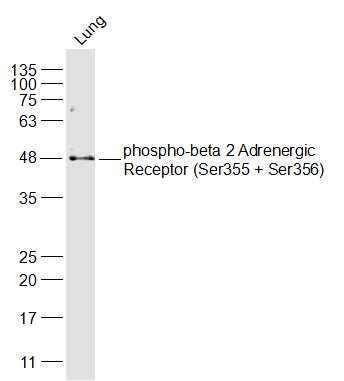产品货号 : mlR12979
英文名称 : phospho-beta 2 Adrenergic Receptor (Ser355 + Ser356)
中文名称 : 磷酸化肾上腺素能受体β2/β2-AR抗体
别 名 : beta 2 Adrenergic Receptor (phospho S355 + S356); beta 2 Adrenergic Receptor (phospho S346); p-beta 2 Adrenergic Receptor (phospho S346); β2-adrenergic receptor; beta 2 Adrenergic Receptor; ADRB2; ADRB2R; ADRBR; ADRB2_HUMAN; Adrenergic beta 2 receptor surface; B2AR; BAR; beta 2 adrenoceptor; Beta 2 adrenoreceptor; BETA2AR; Catecholamine receptor; beta2-adrenergic receptor.
产品类型 : 磷酸化抗体
研究领域 : 肿瘤 细胞生物 神经生物学 信号转导 细胞膜受体 细胞膜蛋白
抗体来源 : Rabbit
克隆类型 : Polyclonal
交叉反应 : Human, Mouse, Rat, Rabbit,
产品应用 : WB=1:500-2000 ELISA=1:500-1000
not yet tested in other applications.
optimal dilutions/concentrations should be determined by the end user.
分 子 量 : 46kDa
细胞定位 : 细胞膜
性 状 : Lyophilized or Liquid
浓 度 : 1mg/ml
免 疫 原 : KLH conjugated synthesised phosphopeptide derived from human beta 2 Adrenergic Receptor around the phosphorylation site of Ser355 + Ser356:GY(p-S)(p-S)N
亚 型 : IgG
纯化方法 : affinity purified by Protein A
储 存 液 : 0.01M TBS(pH7.4) with 1% BSA, 0.03% Proclin300 and 50% Glycerol.
保存条件 : Store at -20 °C for one year. Avoid repeated freeze/thaw cycles. The lyophilized antibody is stable at room temperature for at least one month and for greater than a year when kept at -20°C. When reconstituted in sterile pH 7.4 0.01M PBS or diluent of antibody the antibody is stable for at least two weeks at 2-4 °C.
PubMed : PubMed
产品介绍 : Beta 2 Adrenergic Receptor is a member of the G protein coupled receptor superfamily. This receptor is directly associated with one of its ultimate effectors, the class C L type calcium channel Ca(V)1.2. This receptor channel complex also contains a G protein, an adenylyl cyclase, cAMP dependent kinase, and the counterbalancing phosphatase, PP2A. The assembly of the signaling complex provides a mechanism that ensures specific and rapid signaling by this G protein coupled receptor. This gene contains no introns in either its coding or untranslated sequences. Different polymorphic forms, point mutations, and/or downregulation of this gene are associated with nocturnal asthma, obesity and type 2 diabetes. Expression of the beta 2 Adrenergic Receptor has been reported in adipose, blood, brain, heart, lung, nose, pancreas, skeletal muscle, skin, and vessel.
Function:
Beta-adrenergic receptors mediate the catecholamine-induced activation of adenylate cyclase through the action of G proteins. The beta-2-adrenergic receptor binds epinephrine with an approximately 30-fold greater affinity than it does norepinephrine.
Subunit:
Binds SLC9A3R1 and GPRASP1. Interacts with ARRB1 and ARRB2. Interacts with SRC, USP20 and USP33. Interacts with VHL; the interaction, which is increased on hydroxylation of ADRB2, ubiquitinates ADRB2 leading to its degradation. Interacts with EGLN3; the interaction hydroxylates ADRB2 facilitating VHL-E3 ligase-mediated ubiquitination.
Subcellular Location:
Cell membrane; Multi-pass membrane protein. Note=Colocalizes with VHL at the cell membrane.
Post-translational modifications:
Palmitoylated; may reduce accessibility of Ser-345 and Ser-346 by anchoring Cys-341 to the plasma membrane. Agonist stimulation promotes depalmitoylation and further allows Ser-345 and Ser-346 phosphorylation.
Phosphorylated by PKA and BARK upon agonist stimulation, which mediates homologous desensitization of the receptor. PKA-mediated phosphorylation seems to facilitate phosphorylation by BARK.
Phosphorylation of Tyr-141 is induced by insulin and leads to supersensitization of the receptor.
Polyubiquitinated. Agonist-induced ubiquitination leads to sort internalized receptors to the lysosomes for degradation. Deubiquitination by USP20 and USP33, leads to ADRB2 recycling and resensitization after prolonged agonist stimulation. USP20 and USP33 are constitutively associated and are dissociated immediately after agonist stimulation. Ubiquitination by the VHL-E3 ligase complex is oxygen-dependent.
Hydroxylation by EGLN3 occurs only under normoxia and increases the interaction with VHL and the subsequent ubiquitination and degradation of ADRB2.
Similarity:
Belongs to the G-protein coupled receptor 1 family.
Adrenergic receptor subfamily. ADRB2 sub-subfamily.
SWISS:
P07550
Gene ID:
154
Important Note:
This product as supplied is intended for research use only, not for use in human, therapeutic or diagnostic applications.
产品图片












